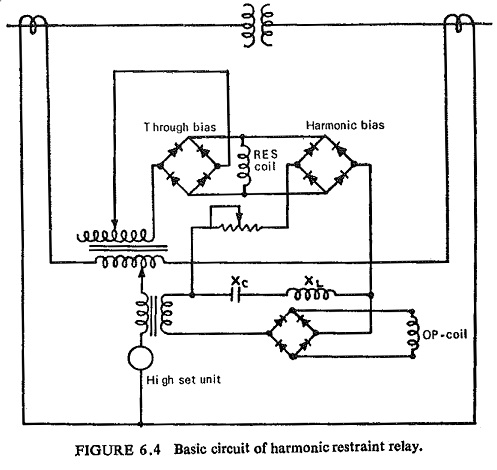Inrush Currents in Transformer:
Magnetizing Inrush Currents in Transformer contain pronounced harmonics but the current during internal fault conditions is sinusoidal. Advantage is taken of this fact in the design of the relay. It was pointed out earlier that for high speed and low primary operating current the harmonic content of the current is filtered and employed for restraint. Following are some of the methods.
(i) Even Harmonic Cancellation: For a typical waveform the harmonics as a percentage of the fundamental wave are given in Table 6.1.
In this method the 3rd harmonic and its multiples do not appear in the CT leads since these components circulate in the delta winding of the transformer and the delta connected CTs on the star side of the transformer. The d.c. components and the even harmonics can be cancelled out in the operating circuit of the rectifier bridge relay and employed for restraint. The 5th and 7th harmonics are small in magnitude and thus can be ignored.
(ii) Harmonic Restraint: This is a very popular method of making the differential relays immune to magnetizing Inrush Currents in Transformer. Figure (6.4) shows the basic circuit of harmonic restraint relay. The restraint coil is energized by a d.c. proportional to bias winding current as well as the d.c. due to harmonics. Harmonic restraint is obtained from the tuned circuit XCXL which permits only currents of fundamental frequency to enter the operating circuit.
The d.c. and higher harmonics (mostly 2nd) are diverted into the rectifier bridge feeling the restraining coil. The relay is adjusted so that it will not operate when the harmonic current (restraining) exceeds 15% of the fundamental current (operating). Both the d.c. and higher harmonics are of large magnitude during magnetizing inrush.
The harmonic restraint feature may result in the failure of the relay to operate on an internal fault if considerable harmonics are present. These harmonics may be present in the fault current itself due to an arc, or the current transformer may saturate and produce harmonics. Also, if a fault exists at the time a transformer is energized, harmonics in the magnetizing current may prevent it from tripping.
For this purpose it is customary to provide an instantaneous overcurrent relay in the differential circuit which is set above the maximum Inrush Currents in Transformer but will operate in less than one cycle on internal faults. In this way fast tripping is assured for all internal faults.

